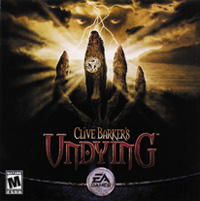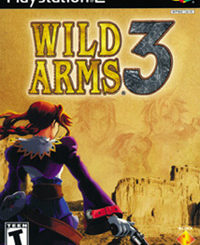 Clive Barker’s Undying
Clive Barker’s Undying
(Electronic Arts for the PC)
by Eric Johnson
Exiled Irishman and Great War veteran Patrick Galloway is a man who has seen too much. His most terrible demons were not conjured by the mechanized butchery of the trenches or at the bottom of a bottle of Jamiesons but from his investigation of that which should not be. His return to his homeland was not by choice but obligation, to a dying man who once saved his life. Powerless to stop his friend’s slow wasting death, Galloway is compelled to look into the bizarre events and haunting visions that have surrounded the mysterious destruction of his old friend’s family.
Undying plays a lot like Quake, but at its heart is a good old-fashioned ghost story. Supernatural, hard-boiled detective fiction set on cursed ancestral land built over the remains of a medieval monastery. Forbidden knowledge, levitating specters, family secrets, mutilated servants, haunted paintings, long hallways, petroglyphs, and demonic, otherworldly creatures conspire to weave a tale so terrible as to keep even old H.P. glued to his chair. Of course, there’s far more action than the old master would have approved of, but it’s also chock full of atmosphere, tension, and genuine scares. The man primarily responsible for this exceptional yarn is horror writer Clive Barker, who didn’t pen the script from scratch, but took over the project midway through, exhibiting a surprising aptitude for manipulating a medium who’s storytelling potential is too often neglected.
Most likely, you’ve played a game like this before. After all, it’s an action game… It feels like an interactive movie, but the majority of playtime is spent exploring and shooting. Actually, it’s mostly spent backing up and juggling weapons while confronted by overwhelming hordes of unnatural beasts! It’s similar to an untold number of other first-person shooters, but unlike Quake or Unreal Tournament, it’s composed of a long and richly detailed single-player adventure. The plot is revealed through conversations with house servants, discarded writings, and psychic visions. Survival requires reliance on an arsenal of traditional weapons and well-crafted magical spells. The first and most unique of these spells is the Scrye, a second sight that allows you to catch glimpses of past events. Mystical visions provide some of the eeriest moments in Undying, as this power lets you witness first-hand the psychic scars that litter the Covenant estate. Through proper use of the Scrye, you may see a hanging man choke on his final breath, or discover the true nature of an individual by the transformation of their portrait. I’d recommend keeping an ear out for the disembodied voice that beckons you to use this power. It provides a nice counterpoint to Undying‘s occasionally frantic pace, and it allows the disturbing atmosphere of the Covenant estate to sink in.
Undying takes full advantage of the recent advances in graphics technology, and requires a beefy machine to run properly. As a result, the environment is rendered in astonishing detail. The architecture is something to behold: Vaulted ceilings, stained glass, enough hound’s tooth and molded wood to make a WASP think he’s died and gone to heaven. Lovecraft fans will find some inside jokes here, including a stained glass window complete with octopus motif. Each human in the game has a distinct and realistic appearance without repetition; you will not confront the identical twin of a dead maid later in the game. A nice effect. Sound is brilliantly used to generate tension, and with the proper speaker setup, can be used to locate attackers creeping up on you. The music is predominantly atmospheric and effectively manipulates the tension at key moments throughout the game. The voice acting is exceptionally well done, a collection of convincing Irish accents commendable for their authenticity. The controls are a little contrived, but easy enough to grow used to in time, and certainly not complicated enough to interrupt immersion in the game.
Of course, there are little things about the game that left a sour taste in my mouth. A little more exploration and freedom would have been nice. Because of the overwhelmingly action-oriented game play, the game is not quite as frightening as it could be. More complex interaction with the environment, like that of the four year old System Shock 2, would’ve added a great deal to the tension and boosted the fear element. The lack of multiplayer options and the set-in-stone linearity of the narrative cut down on some replay value, but the adventure that this game puts you on is compelling enough to carry you through to the end. It’s a great example of how far a good makeover and a strong storyline can go to make the overwhelmingly familiar seem new.
Undying was a genuine surprise. I’ve generally snatched up horror-based video games wherever I’ve found them, and although the list is relatively short, there’s some stiff competition out there. While not as frightening as Silent Hill, a PlayStation game that genuinely freaked the shit out of me a few years ago, it’s the best original work to come down the pipe in some time. As previously stated, the storytelling potential of this medium has barely been tapped, and it’s ability to inspire fear has no limit. Anyone who’s enjoyed horror movies or games in the past should consider it highly recommended. Of all the big name horror writers, Clive Barker was a remarkably good choice to help craft this tale, primarily because of his unique ability to balance the types of fear: He has good ideas, a strong sense of visual imagery, allows just enough of his sexual hang-ups loose, generates atmosphere, doesn’t give in to excessive humor, and spins a good yarn that doesn’t fall apart at the climax. These skills have served his films well, and they come together here with excellent results.
(www.ea.com)



